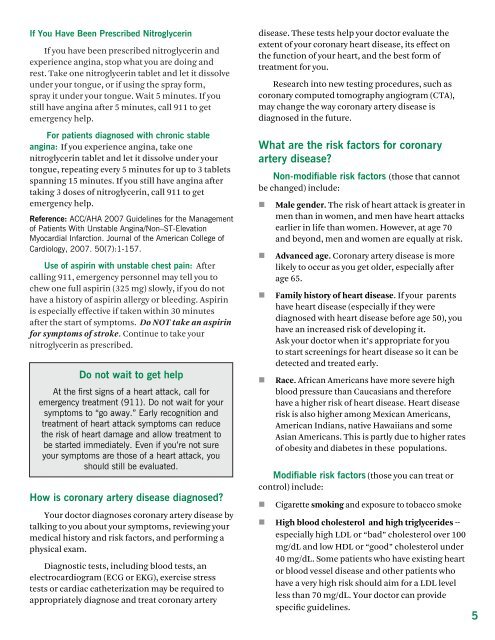Coronary Artery Disease Treatment Guide - Cleveland Clinic
Coronary Artery Disease Treatment Guide - Cleveland Clinic
Coronary Artery Disease Treatment Guide - Cleveland Clinic
Create successful ePaper yourself
Turn your PDF publications into a flip-book with our unique Google optimized e-Paper software.
if you have Been Prescribed nitroglycerin<br />
If you have been prescribed nitroglycerin and<br />
experience angina, stop what you are doing and<br />
rest. Take one nitroglycerin tablet and let it dissolve<br />
under your tongue, or if using the spray form,<br />
spray it under your tongue. Wait 5 minutes. If you<br />
still have angina after 5 minutes, call 911 to get<br />
emergency help.<br />
For patients diagnosed with chronic stable<br />
angina: If you experience angina, take one<br />
nitroglycerin tablet and let it dissolve under your<br />
tongue, repeating every 5 minutes for up to 3 tablets<br />
spanning 15 minutes. If you still have angina after<br />
taking 3 doses of nitroglycerin, call 911 to get<br />
emergency help.<br />
Reference: ACC/AHA 2007 <strong>Guide</strong>lines for the Management<br />
of Patients With Unstable Angina/Non–ST-Elevation<br />
Myocardial Infarction. Journal of the American College of<br />
Cardiology, 2007. 50(7):1-157.<br />
use of aspirin with unstable chest pain: After<br />
calling 911, emergency personnel may tell you to<br />
chew one full aspirin (325 mg) slowly, if you do not<br />
have a history of aspirin allergy or bleeding. Aspirin<br />
is especially effective if taken within 30 minutes<br />
after the start of symptoms. Do NOT take an aspirin<br />
for symptoms of stroke. Continue to take your<br />
nitroglycerin as prescribed.<br />
do not wait to get help<br />
At the first signs of a heart attack, call for<br />
emergency treatment (911). Do not wait for your<br />
symptoms to “go away.” Early recognition and<br />
treatment of heart attack symptoms can reduce<br />
the risk of heart damage and allow treatment to<br />
be started immediately. Even if you’re not sure<br />
your symptoms are those of a heart attack, you<br />
should still be evaluated.<br />
how is coronary artery disease diagnosed?<br />
Your doctor diagnoses coronary artery disease by<br />
talking to you about your symptoms, reviewing your<br />
medical history and risk factors, and performing a<br />
physical exam.<br />
Diagnostic tests, including blood tests, an<br />
electrocardiogram (ECG or EKG), exercise stress<br />
tests or cardiac catheterization may be required to<br />
appropriately diagnose and treat coronary artery<br />
disease. These tests help your doctor evaluate the<br />
extent of your coronary heart disease, its effect on<br />
the function of your heart, and the best form of<br />
treatment for you.<br />
Research into new testing procedures, such as<br />
coronary computed tomography angiogram (CTA),<br />
may change the way coronary artery disease is<br />
diagnosed in the future.<br />
What are the risk factors for coronary<br />
artery disease?<br />
Non-modifiable risk factors (those that cannot<br />
be changed) include:<br />
<br />
<br />
<br />
<br />
Male gender. The risk of heart attack is greater in<br />
men than in women, and men have heart attacks<br />
earlier in life than women. However, at age 70<br />
and beyond, men and women are equally at risk.<br />
Advanced age. <strong>Coronary</strong> artery disease is more<br />
likely to occur as you get older, especially after<br />
age 65.<br />
Family history of heart disease. If your parents<br />
have heart disease (especially if they were<br />
diagnosed with heart disease before age 50), you<br />
have an increased risk of developing it.<br />
Ask your doctor when it’s appropriate for you<br />
to start screenings for heart disease so it can be<br />
detected and treated early.<br />
Race. African Americans have more severe high<br />
blood pressure than Caucasians and therefore<br />
have a higher risk of heart disease. Heart disease<br />
risk is also higher among Mexican Americans,<br />
American Indians, native Hawaiians and some<br />
Asian Americans. This is partly due to higher rates<br />
of obesity and diabetes in these populations.<br />
Modifiable risk factors (those you can treat or<br />
control) include:<br />
<br />
<br />
Cigarette smoking and exposure to tobacco smoke<br />
High blood cholesterol and high triglycerides -especially<br />
high LDL or “bad” cholesterol over 100<br />
mg/dL and low HDL or “good” cholesterol under<br />
40 mg/dL. Some patients who have existing heart<br />
or blood vessel disease and other patients who<br />
have a very high risk should aim for a LDL level<br />
less than 70 mg/dL. Your doctor can provide<br />
specific guidelines.<br />
5

















